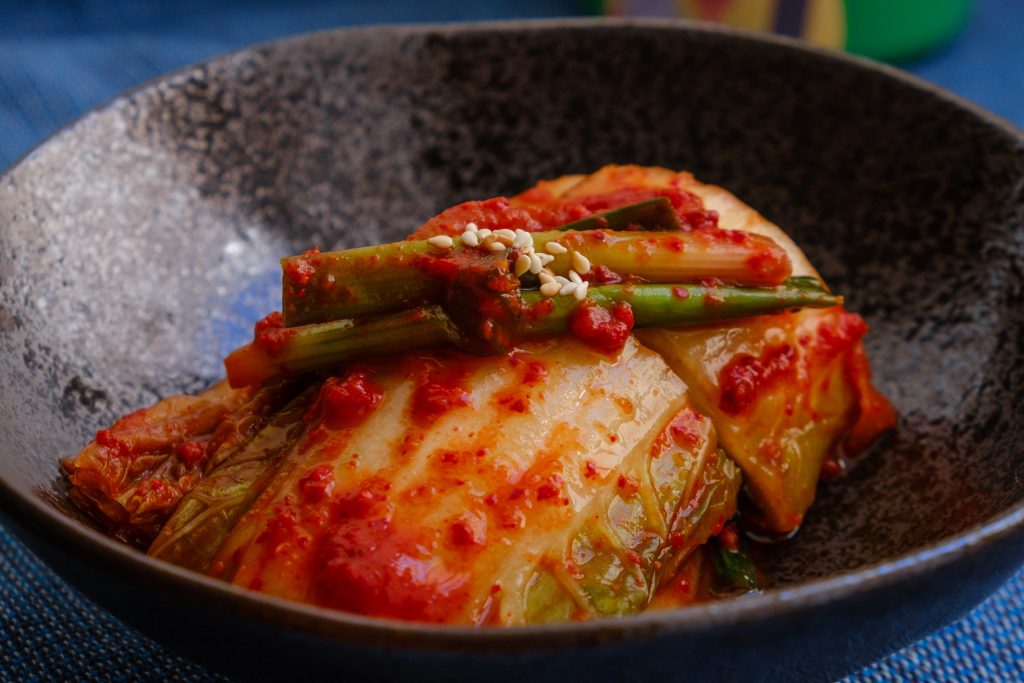- Home
- Explore
arrow_drop_down
- News & Articles
arrow_drop_down
- More
arrow_drop_down
- Contact Us (연락)
- @KoreatownOnline
What is Kimchi?
- FAQs
-
Aug 21
-
Andrew Kang
- Share post

Introduction
Kimchi is a traditional, fermented Korean food that is prepared through a series of processes, including pretreatment of oriental cabbage (or radish), brining, blending with various spices and other ingredients, and fermentation. The characteristics of kimchi differ depending on the kimchi varieties, raw materials used, process, fermentation, and preservation methods. However, kimchi has typical biochemical, nutritional, and organoleptic properties and health‐related functions.
Table of Contents
Fermentation
Kimchi fermentation is initiated by various microorganisms originally present in the raw materials, but the fermentation is gradually dominated by lactic acid bacteria. Numerous physicochemical and biological factors influence the fermentation, growth, and sequential appearance of principal microorganisms involved in the fermentation. Complex biochemical changes occur depending on the environmental conditions before, during, and after fermentation.
The most important characteristics are the compositional changes of sugars and vitamins (especially ascorbic acid), formation and accumulation of organic acids, and texture degradation and softening. Nutritionally, kimchi is an important source of vitamins, minerals, dietary fiber, and other nutrients.
Health Benefits of Kimchi
Many bacterias are involved in the fermentation of kimchi, but Lactic acid – bacteria (LAB) became dominant when the putrefactive bacteria were suppressed during salting of baechu cabbage and the fermentation. The addition of other sub ingredients and formation of fermentation byproducts of LAB promote the fermentation process of LAB to eventually lead to eradication of putrefactive- and pathogenic bacteria, and also increase the functionalities of kimchi.
Accordingly, kimchi can be considered a vegetable pro-biotic food that contributes to health benefits in a similar manner as yogurt does, as a dairy pro-biotic food. Further, the major ingredients of kimchi are cruciferous vegetables; and other healthy functional foods such as garlic, ginger, red pepper powder, and so on which are added to kimchi as sub-ingredients. As all of these ingredients undergo fermentation by LAB, kimchi is regarded as a source of LAB; and the fermentative byproducts from the functional ingredients significantly boost its functionality.
Because kimchi is both tasty and highly functional, it is typically served with steamed rice at every Korean meal, it is also a popular Korean side dish. Health functionality of kimchi includes anticancer, antiobesity, anticonstipation, colorectal health promotion, probiotic properties and cholesterol reduction, fibrolytic effect, antioxidative and antiaging properties, brain health promotion, immune promotion, and skin health promotion as well.
Popular Types of Kimchi
Baechu Kimchi (Napa Cabbage)
Made with salted and rinsed cabbage this type of kimchi is commonly reffered to as only “kimchi” and is packed with red pepper flakes, garlic, ginger, green onion, fish sauce etc. It is then put into a container to ferment during storage and can be kept for months or even longer, it becomes more sour and better fermented with time.
Kakkdugi (Cubed Radish)
Kkakdugi is made of cubed Korean radish and is prepared with almost the same ingredients and in the same way as baechu kimchi, the only difference is that kkakdugi is juicy and crunchy. This kind of kimchi goes well with almost everything but is a traditional companion of seolleongtang, a milky white soup made from ox bones and brisket.
Chonggak (Ponytail Radish)
This kimchi is made with a small white radish (chonggak) that comes with a ponytail and is prepared using red pepper flakes, ginger, onions etc. Chonggak is also known as bachelor radish as it reminds people of a hairstyle that was once worn by unmarried men in Korea.
Oi Sobagi (Cucumber Kimchi)
Oi sobagi (“stuffed cucumber”) is a refreshing, crisp, and spicy variation on the general kimchi. Korean cucumbers are sliced in quarters lengthwise, keeping one end intact, and the resulting pocket is stuffed with finely chopped vegetables like carrot, onion, sometimes radish, ginger, and garlic. It’s good for summer and not meant to be stored for a long time—just a few days. It goes well with soups and stews.
Bossam (Wrapped Radish)
The word bossam in Korean indicates something wrapped and is also the name of a popular Korean meal. This type of kimchi contains fish, jujubes, oysters or shrimp, mushrooms, chestnuts, pine nuts, mustard leaf, radish, pear, green onion, watercress…all wrapped in whole wilted cabbage leaves and rolled up into a ball, it is then left to ferment for three to four days and is ready to serve.
Wrapping it Up
Kimchi is the iconic dish of Korean cuisine and has been gaining popularity worldwide in the past decade or so for its health benefits and its just plain deliciousness. Most people who are new to Korean food think of kimchi as the red, spicy, garlic-laden fermented cabbage dish that usually accompanies the main courses in Korean restaurant meals or that is served in kimchi jjigae (stew), kimchi pancakes, and kimchi fried rice, but kimchi is much more than that….

